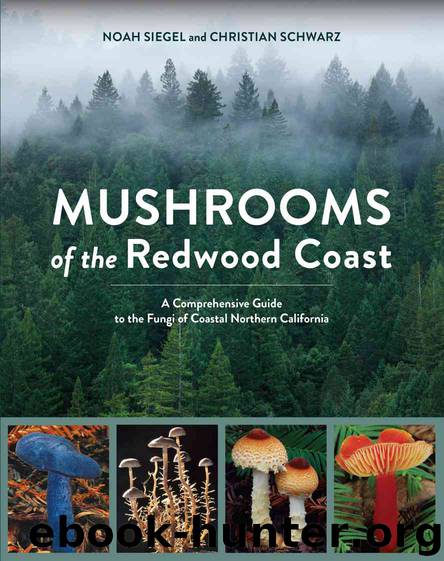Mushrooms of the Redwood Coast by Noah Siegel

Author:Noah Siegel [Siegel, Noah]
Language: eng
Format: epub
Publisher: Potter/TenSpeed/Harmony
Published: 2016-08-09T00:00:00+00:00
Hygrocybe flavescens
(Kauffman) Singer
YELLOW WAXY CAP
CAP: 2–8 cm across, convex to plane with a small umbo, margin becoming uneven, mature specimens often wavy. Pale lemon yellow to bright yellow or yellowish orange, fading in age. Surface moist to viscid when wet, often dry in older specimens or in dry weather, and often with debris stuck to the cap. GILLS: Notched to narrowly attached, subdistant, narrow to broad, soft, greasy. Off-white to pale yellow when young, staying pale yellow or becoming darker yellow to yellowish orange in age. STIPE: 3–5 cm long, 0.5–1.5 cm thick, more or less equal, usually developing a longitudinal groove in age. Yellow, pale lemon yellow or yellowish orange. Surface fibrous to smooth, moist to slippery when wet, quickly drying out. FLESH: Creamy white to pale yellow, stipe stuffed when young, becoming hollow. ODOR: Indistinct. TASTE: Indistinct. KOH: Bleaching cap pigment. SPORE DEPOSIT: White. MICROSCOPY: Spores 7.5–9 × 4–5 µm, averaging 8.4 × 4.3 µm, ellipsoid, smooth, inamyloid, colorless.
ECOLOGY: Solitary, scattered, or in small clusters in humus and duff, most often under redwood, but can be found in many forest types. Common throughout our range. Fruiting from late fall into spring.
EDIBILITY: Reportedly edible.
COMMENTS: This common waxy cap is best identified by the viscid, convex to plane, yellow to yellow-orange cap without any red tones and the whitish to yellow gills and stipe. Some authors consider H. chlorophana to be a separate species, distinguished by a viscid stipe and more orange cap. We consider these more orange and slightly viscid-stalked specimens to be within the range of variation for H. flavescens. H. acutoconica is similar, but has a more peaked-conical, yellow-orange to reddish cap and a fibrous stipe. Faded fruitbodies of the much rarer H. virescens can be similar, but have dry caps and usually at least faint traces of greenish hues.
Download
This site does not store any files on its server. We only index and link to content provided by other sites. Please contact the content providers to delete copyright contents if any and email us, we'll remove relevant links or contents immediately.
| Anatomy | Animals |
| Bacteriology | Biochemistry |
| Bioelectricity | Bioinformatics |
| Biology | Biophysics |
| Biotechnology | Botany |
| Ecology | Genetics |
| Paleontology | Plants |
| Taxonomic Classification | Zoology |
Sapiens: A Brief History of Humankind by Yuval Noah Harari(14252)
The Tidewater Tales by John Barth(12608)
Mastermind: How to Think Like Sherlock Holmes by Maria Konnikova(7227)
Do No Harm Stories of Life, Death and Brain Surgery by Henry Marsh(6891)
The Thirst by Nesbo Jo(6828)
Why We Sleep: Unlocking the Power of Sleep and Dreams by Matthew Walker(6618)
Life 3.0: Being Human in the Age of Artificial Intelligence by Tegmark Max(5474)
Sapiens by Yuval Noah Harari(5294)
The Longevity Diet by Valter Longo(5021)
The Body: A Guide for Occupants by Bill Bryson(4974)
The Rules Do Not Apply by Ariel Levy(4861)
The Immortal Life of Henrietta Lacks by Rebecca Skloot(4525)
Animal Frequency by Melissa Alvarez(4395)
Why We Sleep by Matthew Walker(4360)
The Hacking of the American Mind by Robert H. Lustig(4318)
Yoga Anatomy by Kaminoff Leslie(4306)
All Creatures Great and Small by James Herriot(4233)
Double Down (Diary of a Wimpy Kid Book 11) by Jeff Kinney(4207)
Barron's AP Biology by Goldberg M.S. Deborah T(4098)
